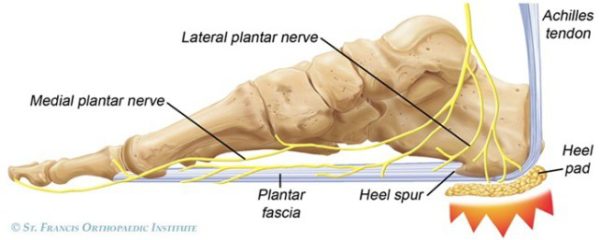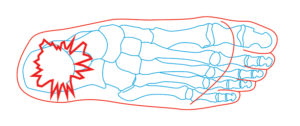My Inner Heel of My Foot Is Black and Blue
Bruised Heel (Fat Pad Contusion)
By Terry Zeigler, EdD, ATC
Sports participation can place the foot at risk for a number of injuries including a bruised heel or Fat Pad Contusion. Because the calcaneus is the largest bone in the foot and the primary weight-bearing bone, it is subject to injury. Although ankle sprains are the most common ankle/foot injury, a heel bruise can be quite debilitating.
A heel bruise can be a painful injury and can be the result of either one acute injury or from repetitive impact on the foot. Although moderate injuries can result in a contusion to the fat pad surrounding the calcaneus or a deep bone bruise, repetitive injuries can result in a calcaneal stress fracture.
What is a bruised heel?
The calcaneus is the bone in the foot that bears most of the weight during the heel strike phase of an athlete's forward movement. The weight of the athlete is transferred from the tibia through the talus (smaller tarsal bone) and to the calcaneus during heel strike before the athlete's weight is transferred through the other small tarsal bones on through the metatarsals and out through the toes.
The calcaneus is at risk for injury because it is the sole bone that makes initial contact with the ground when the athlete walks, jogs, or lands from a jump. Surrounding the calcaneus is elastic adipose (fat) tissue for the purpose of cushioning and protecting the calcaneus from impact injuries.
Regardless of the cause, the outcome to the athlete is bruising on the bottom of the heel that and feels like pain directly at the bottom of the heel.
What is the classification of heel injuries?
A heel injury can include a range of injuries from mild (bruise) to moderate (stress fracture or bone bruise) to severe (fracture of the calcaneus). The severity of the injury depends on the amount of force placed on the calcaneus.
An injury resulting in a heel bruise may result in pain during walking or weight bearing, swelling in and around the heel, and tenderness of the heel to pressure. Injury to the heel pad might also result in displacement of the heel pad laterally and medially (to either side) resulting in a flat spot under the calcaneus compared to the uninjured foot. If the athlete continues to work out on a bruised heel, the injury may develop into chronic inflammation of the periosteum (outside perimeter of the bone) a much more debilitating injury.
Calcaneal stress fractures have been associated with excessive marching (as in the military) on hard surfaces in boots without quality shock absorption or in long distance runners. Besides calcaneal stress fractures, other bones that have a higher risk for a stress fracture in the foot include the navicular, the metatarsals, and the sesamoid bones (underneath the head of the first metatarsal).

A complete fracture of the calcaneus needs a significant amount of force. One type of force strong enough to fracture the calcaneus is seen in the sport of sky diving during the landing phase (calcaneus can be shattered on a hard landing). Although deformity is not usually associated with a fractured calcaneus, the athlete would not be able to walk and would have immediate swelling and pain.
How is a bruised heel diagnosed?
A bruised heel can be diagnosed by a sports medicine professional through a thorough medical history and clinical evaluation. If a stress fracture is suspected, the physician may order a bone scan. A fractured calcaneus can be detected through the use of a routine x-ray.
Who gets a bruised heel?
Although thicker bones are generally more resistant to stress injuries, athletes who repetitively land from jumping may be at risk for heel bruises. According to Bahr and Maehlum (2004), "long jumpers and triple jumpers are particularly vulnerable" to this type of injury.
However, any athlete participating in a sport that requires repetitive landing on the feet can be at risk for this type of injury. This might include athletes in the sports of indoor volleyball, basketball, beach volleyball, long distance running and skateboarding .
What causes a bruised heel?
The foot is subject to stress anytime an athlete runs, jumps, and changes directions. However, specific factors may place an athlete at risk for heel injuries including the following:
• Excessive body weight
• Age
• Poorly cushioned or worn-out running shoes
• Increases in training
• Hard, uneven training surfaces
• Walking or training barefoot
A heel bruise can be caused by a one-time incident of the athlete landing on his/her heel from a height (or in poor shoes) or from repetitive trauma over time (running on the beach without shoes).
What can I do to prevent a bruised heel?
Reviewing the factors that may place an athlete at risk for heel bruise is a good place to start to prevent a heel injury. Because shoes with poor shock absorption may place an athlete at risk for heel injuries, careful selection of shoes should be a priority for athletes especially in sports that require a lot of running, jumping, and changes of direction.

Runners should replace their shoes often so as to ensure that the quality of the shock absorption components of the shoe is still effective and able to prevent heel injuries. Athletes should research shoe designs and purchase a shoe that is specifically designed for their sport and for their foot.
Athletes should also take care to wear shoes when training especially when training on uneven surfaces like the beach. Athletes may mistakenly believe that the soft surface of the sand may prevent injuries to the foot, but the outcome of a run on the sand may be the opposite.
Along with sustaining heel injuries from running barefoot on the beach; uneven surfaces may also cause injury to the muscles on the inside and/or outside of the ankle (strained peroneal muscles and/or strained tibialis posterior).
Bruised heel Treatment
Bruised heel treatment goals are to reduce the pain and swelling and prevent any further injury. Acute heel bruises can be easily treated using the P.R.I.C.E. principles – Protection, Rest, Icing, Compression, Elevation. Ice can be applied either through an ice bag or through cold water immersion (ice bucket). Ice should be applied for twenty minutes at a time every two hours for the first two to three days.
After research and reading reviews, SportsMD thinks these cold foot and ankle therapy products should be considered for a bruised heel. What we liked most is the elastic straps help provide good fit and compression and the combination of the inserts and antimicrobial fabric.
To protect the injured heel, the athlete should not walk on the heel until the heel is pain free during weight-bearing. can be used during the time that the heel is painful. The athlete should be non-weight bearing during the first day or two (depending on the athlete's pain) moving to partial weight-bearing as tolerated.
It is important for the athlete to not push through the pain in this type of injury. Practicing and playing with heel pain may place the athlete at risk for a more serious injury including damage to the outer lining of the bone (periosteum). Playing with heel pain could turn a short rehabilitation period into a long one.
Once the pain has subsided, the athlete may choose to resume activity with a heel cup and consider. Last, the athlete should ensure that his/her shoes have sufficient cushion to protect the heel when returning to sport.
SportsMD thinks the following heel cups are the best products for most people looking to recover from bruised heel. What we liked most is the heel comfort and shock absorption.
Runners with heel pain should consider wearing their most weightbearing sneakers during activity until they are healed. These shoes will continue to provide cushion and comfort during rehabilitation.
How to tape a bruised heel
The following video shares how to tape a bruised heel and the best technique to use.
Sports Injuries and When to See the Doctor
Hundreds of athletes sustain acute injuries every day, which can be treated safely at home using the P.R.I.C.E. principle. But if there are signs or symptoms of a serious injury, emergency first aid should be provided while keeping the athlete calm and still until emergency service personnel arrive. Signs of an emergency situation when you should seek care and doctor treatment can include:
- Bone or joint that is clearly deformed or broken
- Severe swelling and/or pain,
- Unsteady breathing or pulse
- Disorientation or confusion
- Paralysis, tingling, or numbness
In addition, an athlete should seek medical care if acute symptoms do not go away after rest and home treatment using the P.R.I.C.E principle.
When Can I Return to Play?
The athlete can return to play when he/she has been released by his/her physician and is pain-free on weight-bearing with all activity.
Virtual Care from Sports Doctors and Specialists
 SportsMD offers Virtual Care and Second Opinion Services. It allows you to quickly and conveniently speak with a sports doctor or specialist and have an effective alternative to emergency room, urgent care, or waiting for a doctors appointment. You can get Virtual Care from your home or anywhere via phone or video chat.
SportsMD offers Virtual Care and Second Opinion Services. It allows you to quickly and conveniently speak with a sports doctor or specialist and have an effective alternative to emergency room, urgent care, or waiting for a doctors appointment. You can get Virtual Care from your home or anywhere via phone or video chat.
Learn more here.
If your heel hurts, it's most often because of: a callus, plantar fasciitis, or a bone bruise? https://t.co/uFF43ae6Kq pic.twitter.com/biSdPvlJsn
— WebMD (@WebMD) December 25, 2017
References
Anderson, M.K., Parr, G.P., & Hall, S.J. (2000). Foundations of Athletic Training: Prevention, Assessment, and Management. (4th Ed.). Lippincott Williams & Wilkins: Baltimore, MD.
Arnheim, D. & Prentice, W. (2009).Principles of Athletic Training.(10th Ed.). McGraw Hill: Boston, MA.
Bahr, R. & Maehlum, S. (2004).Clinical Guide to Sports Injuries. Human Kinetics: Champaign, IL.
Brukner, P. & Khan, K. (2002).Clinical Sports Medicine (2nd Ed.). McGraw Hill: Australia.
Source: https://www.sportsmd.com/sports-injuries/foot-ankle-injuries/bruised-heel-fat-pad-contusion/
0 Response to "My Inner Heel of My Foot Is Black and Blue"
Post a Comment